Instruction
Learning from Ben Hogan’s pivot compression
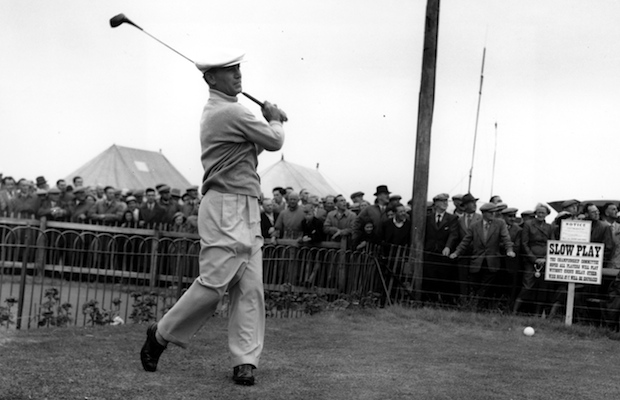
As an instructor, I find every part of the golf swing interesting and certainly have my preferences when it comes to hand, arm and wrist action. However, there is one thing that stands out to me in the swings of many of the game’s greatest players – a pivot action that includes an initial lowering of the body towards the ground during the backswing and again in the first part of the downswing.
This action, which I call “pivot compression,” plays an important role in these players’ ability to deliver a superior strike on the ball. This very same action has often been misidentified by golf analysts and instructors on television as the dreaded “head drop” or “dip,” which they claim should be avoided. I have evidence of pivot compression to be present in over 100 swing analysis videos of tour players, past and present, many of which I have made freely available for anyone to view on my website.
My ideas around pivot compression started to form when I was in my late twenties. After an All-American collegiate career, I tried to play for a living, spending four years on the Space Coast mini-tour. My swing, which incorporated a driving of the legs and a bent-back “reverse c” finish began to take its toll on my lower spine. I advanced to the finals of Q-School in 1985, but wound up in the hospital in traction a week before the event. Needless to say, I didn’t make the cut, and my dream of playing the PGA Tour would never be realized as I could never practice as much as I needed to in order to get better. I did, however, begin to study the golf swing more closely, as I knew I needed to change the nature of my own body movement if I was going to be able to continue to play. My upright backswing and picturesque but highly stressful finish needed to become a more rounded motion that finished with my lower back less arched to reduce the strain put on my lower spine.
I knew that Hogan’s focus on the sidearm/underhand nature of the golf swing motion is was what I needed in my own swing. I studied this book, along with his other classic, Power Golf, in great detail. Soon, with this more rotational movement, I was able to start practicing and playing again, but it wasn’t until a friend showed me actual film of Hogan swinging that I had what I consider an epiphany regarding the way the hips and trunk moved in the swing. There was this great down the line view of Hogan hitting a long iron in the late 1940’s, and as I studied it I saw that a few interesting things were happening in his backswing relating to the lower body movement:
A) Hogan’s right hip went backward behind where it started. In other words, it got deeper, and it did so without his straightening the right knee.
B) His head went down at least 2-to-3 inches.
C) His spine increased angle as his head stayed out over the ball.
He now looked much more bent over, noticeably more than at address, as he compressed his body lower into the ground for power.
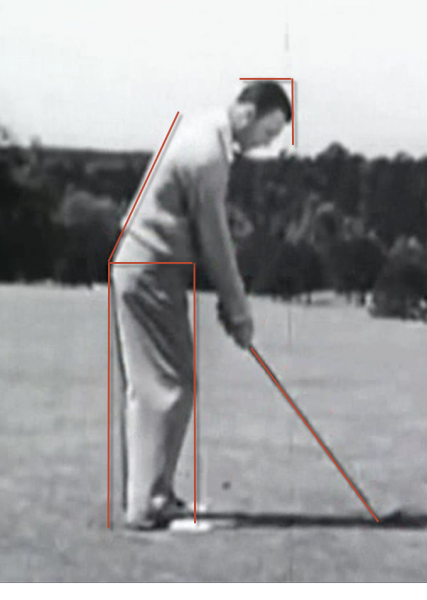
The lines drawn at the setup position are used to define starting points so that we can measure change and how things move in relation to the initial position.
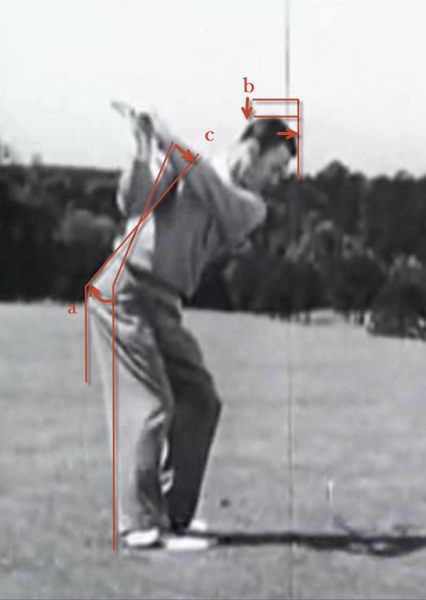
Then, in the forward swing, more cool stuff happened.
D) Hogan’s hips stayed deep as they drove laterally to the left and opened. The lateral element was significant and obvious in all the video footage I had of Hogan from face-on.
E) His head stayed out over the ball.
F) He lowered another 2-to-3 inches from the start of the downswing to just before impact. As he passed by the point where his hips were once again square to the target (just after the left arm reached parallel to the ground in the downswing) they were well further back, or deeper, than they were at address.
G) When he hit the ball, his right arm had oodles of room to get in front of his right hip and he was way more bent over than when he initially addressed the ball.
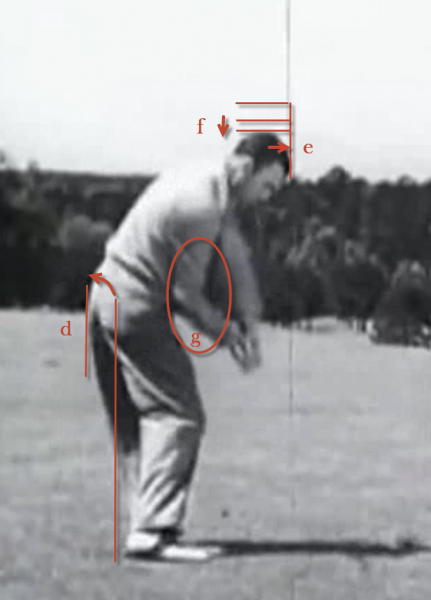
This all leads to the impact position, where we can see that:
H) His head remains lowered and out over the ball.
I) His hips are still much deeper than at address.
J) The right elbow is in front of the right hip.
K) The club is returned perfectly to the shaft plane created at address.
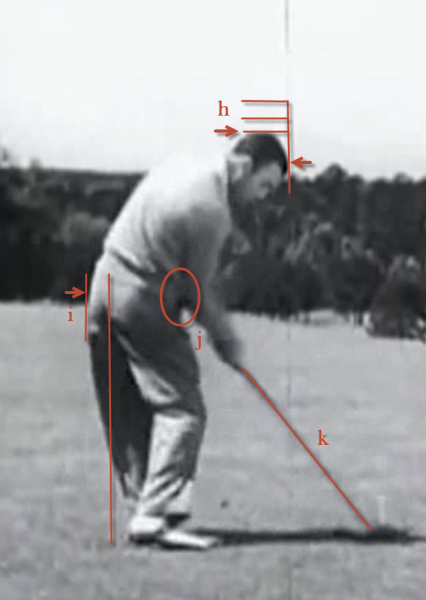
And in the swing finish:
L) Hogan’s head has moved up and away from both impact position and address position (this will take stress away from the lower back).
M) The hips stayed “in the box” that was defined at address.
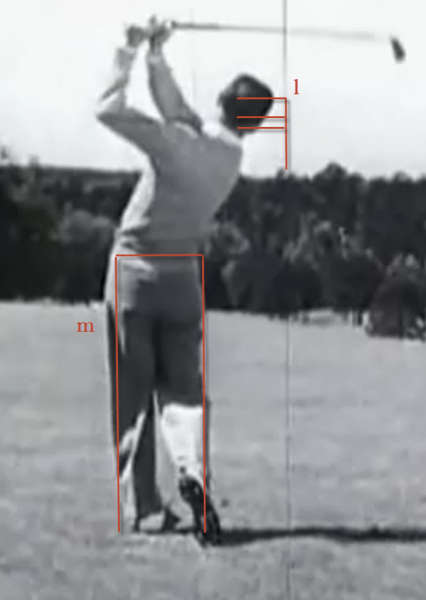
Hogan is considered by most to be the best striker of the golf ball in the history of the game. It is my opinion that he hit his peak in 1949, winning 12 out of 16 events, just before he and his wife got hit by a bus in Texas. Except for the injuries he sustained, which kept him from practicing the way he was accustomed and limited his playing schedule, I believe that Hogan would have won many more majors and would have amassed a record that no one could ever touch, not even the great Jack Nicklaus.
I should note from experience that mastering pivot compression will require more than just good information. Golf is a sport, and the swing is a physical activity that will be best achieved if you are in the best condition possible. And, of course, it is going to require practice. I had a spinal fusion 30 years ago, which makes it extra difficult for me to execute what I see almost all of the best players do with their legs, hips and upper trunk during the swing. To overcome my physical limitations, I have a disciplined workout regimen to help attain the strength and endurance necessary to last through the duration of a tournament.
While I have never been able to practice as much as I would like, the combination of applying pivot compression and physical conditioning to my golf has allowed me to return to competitive play as a PGA Professional, including qualifying and playing in nine major championships along with a victory in the 2001 PGA Professional National Championship. Today, I am teaching students of all levels to use Pivot Compression to become better ball strikers.
Next up: Six Steps to Pivot Compression
- LIKE194
- LEGIT20
- WOW15
- LOL4
- IDHT1
- FLOP2
- OB0
- SHANK3
Instruction
Clement: Laid-off or perfect fade? Across-the-line or perfect draw?

Some call the image on the left laid off, but if you are hitting a fade, this could be a perfect backswing for it! Same for across the line for a draw! Stop racking your brain with perceived mistakes and simply match backswing to shot shape!
- LIKE0
- LEGIT0
- WOW0
- LOL0
- IDHT0
- FLOP0
- OB0
- SHANK1
Instruction
The Wedge Guy: The easiest-to-learn golf basic

My golf learning began with this simple fact – if you don’t have a fundamentally sound hold on the golf club, it is practically impossible for your body to execute a fundamentally sound golf swing. I’m still a big believer that the golf swing is much easier to execute if you begin with the proper hold on the club.
As you might imagine, I come into contact with hundreds of golfers of all skill levels. And it is very rare to see a good player with a bad hold on the golf club. There are some exceptions, for sure, but they are very few and very far between, and they typically have beat so many balls with their poor grip that they’ve found a way to work around it.
The reality of biophysics is that the body moves only in certain ways – and the particulars of the way you hold the golf club can totally prevent a sound swing motion that allows the club to release properly through the impact zone. The wonderful thing is that anyone can learn how to put a fundamentally sound hold on the golf club, and you can practice it anywhere your hands are not otherwise engaged, like watching TV or just sitting and relaxing.
Whether you prefer an overlap, interlock or full-finger (not baseball!) grip on the club, the same fundamentals apply. Here are the major grip faults I see most often, in the order of the frequency:
Mis-aligned hands
By this I mean that the palms of the two hands are not parallel to each other. Too many golfers have a weak left hand and strong right, or vice versa. The easiest way to learn how to hold the club with your palms aligned properly is to grip a plain wooden ruler or yardstick. It forces the hands to align properly and shows you how that feels. If you grip and re-grip a yardstick several times, then grip a club, you’ll see that the learning curve is almost immediate.
The position of the grip in the upper/left hand
I also observe many golfers who have the butt of the grip too far into the heel pad of the upper hand (the left hand for right-handed players). It’s amazing how much easier it is to release the club through the ball if even 1/4-1/2″ of the butt is beyond the left heel pad. Try this yourself to see what I mean. Swing the club freely with just your left hand and notice the difference in its release from when you hold it at the end of the grip, versus gripping down even a half inch.
To help you really understand how this works, go to the range and hit shots with your five-iron gripped down a full inch to make the club the same length as your seven-iron. You will probably see an amazing shot shape difference, and likely not see as much distance loss as you would expect.
Too much lower (right) hand on the club
It seems like almost all golfers of 8-10 handicap or higher have the club too far into the palm of the lower hand, because that feels “good” if you are trying to control the path of the clubhead to the ball. But the golf swing is not an effort to hit at the ball – it is a swing of the club. The proper hold on the club has the grip underneath the pad at the base of the fingers. This will likely feel “weak” to you — like you cannot control the club like that. EXACTLY. You should not be trying to control the club with your lower/master hand.
Gripping too tightly
Nearly all golfers hold the club too tightly, which tenses up the forearms and prevents a proper release of the club through impact. In order for the club to move back and through properly, you must feel that the club is controlled by the last three fingers of the upper hand, and the middle two fingers of the lower hand. If you engage your thumbs and forefingers in “holding” the club, the result will almost always be a grip that is too tight. Try this for yourself. Hold the club in your upper hand only, and squeeze firmly with just the last three fingers, with the forefinger and thumb off the club entirely. You have good control, but your forearms are not tense. Then begin to squeeze down with your thumb and forefinger and observe the tensing of the entire forearm. This is the way we are made, so the key to preventing tenseness in the arms is to hold the club very lightly with the “pinchers” — the thumbs and forefingers.
So, those are what I believe are the four fundamentals of a good grip. Anyone can learn them in their home or office very quickly. There is no easier way to improve your ball striking consistency and add distance than giving more attention to the way you hold the golf club.
More from the Wedge Guy
- The Wedge Guy: Golf mastery begins with your wedge game
- The Wedge Guy: Why golf is 20 times harder than brain surgery
- The Wedge Guy: Musings on the golf ball rollback
- LIKE88
- LEGIT14
- WOW6
- LOL1
- IDHT0
- FLOP4
- OB1
- SHANK8
Instruction
Clement: Stop ripping off your swing with this drill!

Not the dreaded headcover under the armpit drill! As if your body is defective and can’t function by itself! Have you seen how incredible the human machine is with all the incredible feats of agility all kinds of athletes are accomplishing? You think your body is so defective (the good Lord is laughing his head off at you) that it needs a headcover tucked under the armpit so you can swing like T-Rex?
- LIKE0
- LEGIT2
- WOW2
- LOL0
- IDHT0
- FLOP0
- OB0
- SHANK2
-

 19th Hole3 weeks ago
19th Hole3 weeks agoDave Portnoy places monstrous outright bet for the 2024 Masters
-

 19th Hole1 week ago
19th Hole1 week agoJustin Thomas on the equipment choice of Scottie Scheffler that he thinks is ‘weird’
-

 19th Hole3 weeks ago
19th Hole3 weeks agoTiger Woods arrives at 2024 Masters equipped with a putter that may surprise you
-

 19th Hole1 week ago
19th Hole1 week ago‘Absolutely crazy’ – Major champ lays into Patrick Cantlay over his decision on final hole of RBC Heritage
-

 19th Hole2 weeks ago
19th Hole2 weeks agoTwo star names reportedly blanked Jon Rahm all week at the Masters
-

 19th Hole2 weeks ago
19th Hole2 weeks agoReport: LIV Golf identifies latest star name they hope to sign to breakaway tour
-

 19th Hole2 weeks ago
19th Hole2 weeks agoNeal Shipley presser ends in awkward fashion after reporter claims Tiger handed him note on 8th fairway
-

 19th Hole2 weeks ago
19th Hole2 weeks agoBrandel Chamblee has ‘no doubt’ who started the McIlroy/LIV rumor and why












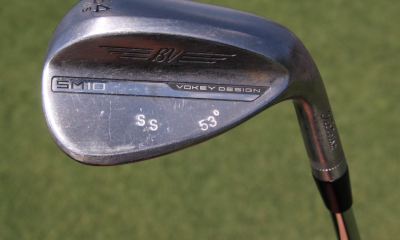



moco
Aug 22, 2016 at 9:51 am
very good- weight on balls of feet & knees over balls of feet (at address), right hip turns deeper than in the address position. Weight compresses into inside right heel. downswing- crunch into that right inside heel (preserves the lag) while turning the core up and around. I’d just be careful about lowering the head, it’s got to move up and around in downswing (don’t hang back).
peter
Jan 3, 2016 at 12:42 am
Wayne with all the lowering these great players do is the reason they do not hit the ball heavy due to shaft lean and the clearing of the lower body?
thx peter
Joseph quaranto
Oct 11, 2015 at 8:26 pm
Would like to hear from you how you move the club up and down. In all my studies the best info is from Greg Mchatton who learned it from Homer Kelly. Kelly and Hogan started at opposite ends of the learning spectrum (mechanics from feel or feel from mchanics) but both arrived at same ball striking perfection. What do you think?
Jones
Mar 27, 2014 at 10:40 pm
Loved the article – good articulation of proper use of lower body, and great analysis of Hogan’s swing in context of that analytic framework. We are eagerly awaiting the next article “Six Steps to Pivot Compression” – when can we expect that?
RAT
Jan 26, 2014 at 9:59 pm
This is good stuff, keep it up!
Carter bonsey
Jan 22, 2014 at 9:17 pm
Excellent analysis. Incidentally, I have been drilling on this for the last three months. I setup with my butt three inches from a half wall but try to touch it with my butt at the top of the bs and maintain contact through to just after impact. This really forces one to stay deep and lower vertical swing plane.
Peter
Dec 15, 2013 at 9:56 pm
Wayne I appreciate your analysis and your humor (…the travel guide “a shrine to Miller in his basement”, best yet!).
I was wondering, do you have a tip for someone who has trouble getting their hips open along with straightening up at impact.
thx
Phil
Dec 14, 2013 at 3:53 am
Point ‘C’ describes the change in angle of Hogan’spine; however the line drawn in the photo is not where his spine is at that point in time (more a line from hip to shoulder)
Jack Gallagher
Aug 23, 2016 at 3:53 pm
True, but if you drew a line from Hogan’s belt buckle at that moment up through the middle of his chest toward his neck/chin, that line would be his spine angle at that time and would be pretty much parallel to line that starts from ‘A’ and goes up to ‘C’. So that Line up to ‘C’ still makes the point, and is simply showing/emphasizing that his spine angle does not “stay the same as it was at address” – which has been a constant in most golf instruction. Instead, his spine angle does something unexpected, becoming more tipped than at address.
HB
Dec 11, 2013 at 10:18 pm
I was watching one of the Australian tour events, and noticed a right-handed Aussie who’s pre-shot routine involved setting up with the blade of his club just to the left of (and behind) the ball and then, just before he began his backswing, it looked like he bent forward to move the blade of his club fully behind the ball. Liking his quick action, I tested this routine on the range and began ripping it dead straight.
Best I can figure out, I got my head my over the ball without my weight going out on to my toes — in short, I am very balanced and getting through the ball better.
I haven’t been able to study this article close enought to see if what I am doing is consistent with what has been outlined. But, I am intrigued — something popped.
FYI, I have always played with a grip close to Hogan’s — I fought a hook when I was young and read just the portion of Hogan’s fundamentals concerning the grip. (I wasn’t much into swing analysis at the time.)
James E. Duh
Dec 11, 2013 at 8:59 pm
http://www.youtube.com/watch?v=mwL4Dus2Vb0
Dear Mr. Defrancesco: Youtube video “Golf – Ernie Els – How to build a classic swing” I was so impressed how still Mr. Els head stays throughout his golf swing as this video shows. I have view many of your and others analysis of swings and as you state, majority of players lower the head in backswing and then lower it further in downswing. the video’s show this clearly. I remember that Jack Nicklaus first teacher, Mr. Grout, use to hold Jack’s hair to keep him from moving is head. Do you think this still head helped Mr. Nicklaus and Mr. Els be so consistent over their careers? Thanks again for all your great video’s Jim
Kujan
Dec 11, 2013 at 6:16 pm
It does make sense that the golfers’ head will be lower given that he’s pushing his hips forward.
jeff rhyne
Dec 7, 2013 at 3:14 pm
Hi Wayne, I enjoy your various pieces.
Something that went unsaid in your article, and I know that space constraints sometimes limit what can be written, but would you like to comment on shaft lean at impact?
I’ve read on many occasions that Hogan, by de-lofting the club, would turn a 7 iron into a 6 iron, for instance. Knowing a little about geometry, wouldn’t it be really difficult to de-loft a club (having the handle of the club in front of the clubhead at impact) without lowering your body? Tiger has a similar move in that he really gets down to the ball.
Just an observation,
thanks for the great articles,
Jeff
wayne defrancesco
Dec 8, 2013 at 5:45 pm
Jeff: Not every great player has lowered, but every great player has forward shaft lean when hitting the ball off the ground. I will say, however, that the vast majority of great players lower at some point in their swing, which by itself can be viewed as proof that lowering is desirable. If you watch Jason Day you will see him maintain his height fairly exactly throughout the swing all the way to impact. He is a rarity, though. Lowering properly by adding posture from the midsection and keeping your head out over the ball creates space for the right arm and elbow to drive in front of the right hip which in turn helps the hands to reach a point even with the ball when the shaft is still angled 90 degrees to the ground. From this point forward shaft lean is guaranteed. If you look at data from 3D analysis and launch monitors you will find that the average amount of shaft lean for tour players with a 7 iron is somewhere around 6-8 degrees. I read recently that Trackman studies of Tour players pitching from around the green off fairway height grass showed an average forward shaft lean of 15 degrees, which would indicate that the ability to lean the shaft has more to do with feel of the club dragging against the hands and being led by the body (meaning that the player has good sequence with the lower body leading the upper in the downswing. I would also say that lowering in the backswing is an indication that the player is loading into the ground, and that further lowering in transition is an indication that the player is using the ground to drive the weight from under the right foot over to the left. That said, I think the article I posted demonstrates why lowering is a good thing to incorporate into your swing and certainly helps in the ability to forward lean the shaft at impact.
Bill Simons
Dec 6, 2013 at 8:47 pm
Wayne,
You mention”… disciplined workout regimen to help attain the strength and endurance…”. What body area(s) do you target in your workouts that allow you to continue this “down move” in your own swing?
Thank you.
wayne defrancesco
Dec 8, 2013 at 5:53 pm
I consider overall strength and fitness to be the goal of any athlete, and so I work out all parts of my body. I happen to have had a spinal fusion (2 levels, lower back) back in 1986, so it is extremely difficult for me to accomplish what I talk about in the article and what I see in the swings that I like the most. Apart from adding strength to my entire body I feel like the legs and midsection are crucial to achieving high level pivot action. I like to take a weighted club (I use the Momentus 3 lb. short club and the 9 lb. extra heavy club) and watch myself in a mirror make slow motion segmented movements that exaggerate what I am trying to do, after which I take a junior club (short and light) and make full motion, full speed swings trying to incorporate the same feelings.
Andrew Cooper
Dec 6, 2013 at 6:54 am
Thanks Wayne, good article. No doubt Hogan (and Woods,, Trevino e.t.c.) lowered through the swing. But could you explain why they did this? What are they gaining by compressing into the ground?
Hogan started from an upright posture, before lowering, and lowering again to impact. Could he simply of started from a less upright posture and achieved a similar impact position? I’d be interested to here your thoughts.
wayne defrancesco
Dec 8, 2013 at 6:04 pm
Good point. I used to tell students that your choice is to stand more upright and then lower, or bend over more and try to maintain that position throughout the swing. Experience has shown me, however, that normal players who bend a lot in the set up almost always tend to raise up during the swing, which is a destructive fault to say the least. Most great players who bend over a lot at address still lower during the swing (Tiger is the best example) but we are talking about athleticism that is well beyond what your average player possesses. I encourage players to have a moderate amount of bend at address and then to load into the ground in the backswing, and then add to that loading in order to drive off the inside of the right foot to start the forward swing, which induces more lowering. If you watch baseball pitchers and infielders you see that lowering in a throwing motion (Hogan was clear about his feeling that the overall motion of the golf swing was comparable to a combination of sidearm and underhand throwing) is an athletic move that is as “natural” as just about anything you do in a golf swing, another reason why labeling it a fault is so ridiculous.
Andrew Cooper
Dec 14, 2013 at 7:46 am
Many thanks for your reply.
Brian
Dec 5, 2013 at 12:30 pm
The best thing I ever did was read 5 lessons. The next best thing I did was ignore most advice given to me unless I found some value in it (I do what this article talks about pretty severely and was told it was a swing fault).
Secret is in the dirt. Only one person can dig in the dirt, and that is the guy with the blade…
Raymond Rapcavage
Dec 5, 2013 at 10:09 am
Absolutely an AWESOME piece by you Wayne…thanks ! You nailed all of the right stuff. Zach Johnson does a lot of what you are speaking and he calls his own swing a “pivot draw”. Yes Hogan went away from the draw but the motion is very similar.
Cheers
Raymond Rapcavage
President
The Golf Swing Shirt Company
reqq
Dec 4, 2013 at 9:21 am
He actually won more majors after his 1949 accident then before it.
wayne defrancesco
Dec 6, 2013 at 2:17 am
The accident just caused him to win way less majors in his career than he would have. I think Hogan had it figured out by 1949 (he was in the process of dominating the Tour)and I know he stated in an interview that he played better after the accident but he never hit it as good as before it. I figure that without the bus he wins 25 majors and is unrivaled as the greatest of all time.
Patrick
Dec 4, 2013 at 8:45 am
Mr. Hogan had it figured out and there isn’t a better swing to emulate… ask Dufner. Well done article.
Spengler
Dec 4, 2013 at 8:19 am
This is great.. Well done
naflack
Dec 4, 2013 at 3:18 am
it is amazing to watch hogan especially having for lack of a better term…”wasted” time trying to emulate him.
my natural swing which resembles that of annika couldnt be more polar opposite, at least in my opinion.
i remember thinking as i tried in vein to do it like hogan…”how in the world do people swing like this”? (lol)
to this day im glad a friend had the sense to tell me to be myself, those were dark days in my golfing journey.
wayne defrancesco
Dec 6, 2013 at 2:04 am
The key phrase in your comment is “do it like Hogan”. What you mean is that you want to “hit it like Hogan”. Or at least, that is what you should have been telling yourself. There is no reward for looking good in golf, even if it means looking like Ben Hogan or a more contemporary player, Adam Scott. I remember watching a guy on the mini-tour back in the 80’s who dressed up like Greg Norman and made his swing look eerily similar. It was like watching an impersonator. Of course, the guy sucked. When you asked “how in the world do people swing like this?”, the answer is that nobody does. Nobody swings like Tiger Woods, Adam Scott, or any other player. People only swing like themselves. You can study the movement and the positions and try to
copy what another player is doing, but when you try to incorporate that into your swing it will just look like you. The greatest example of this is Larry Nelson. He studied the book and taught himself to be a great player in a relatively short period of time, exactly what Hogan wanted to accomplish by writing the book. Nelson’s swing, although he probably felt like it was exactly what Hogan is talking about, never looked anything remotely like Hogan.
naflack
Dec 6, 2013 at 3:47 pm
Truth be told…
If I had it to do over, I’d have never read the book to begin with.
Branden
Dec 3, 2013 at 3:55 pm
Awesome article! I have seen video of my swing and I dip down like Mr. Hogan does in his backswing and follow through, which is something that I had been told by many people was poor fundamentals was to let the head and spine move towards the ball. So naturally, I had worked a bit to try and correct it, only to end up with very poor results. Thank you for this article and reaffirmation that I’m not going anything wrong by moving my body more into the ball.
wayne defrancesco
Dec 6, 2013 at 2:13 am
Unfortunately conventional wisdom says that lowering during the swing is bad and that the idea is to “maintain your posture” and to avoid “dipping”. This idea will eventually fall by the wayside as people begin to understand that the greatest players have nearly all lowered somewhere in their golf swings, some just going back and some just going forward, but many lower in both directions just like Hogan. Of course, it doesn’t help much to have TV announcers, who should know better, continue to sound off (especially about Tiger) about lowering in the swing, blaming it for every type of bad shot. It’s pretty ridiculous with the resource of having video of almost every great player since 1920 that people who should be doing their homework before they start spouting off about what is good and not good in a swing haven’t figured this out. I’m no genius, I just observe what’s in front of me and if I see a huge percentage of the best of all time doing the same thing it’s not a stretch to consider that a good thing to do.
R
Dec 3, 2013 at 2:58 pm
great article, well done